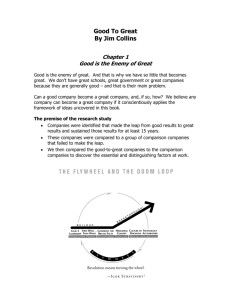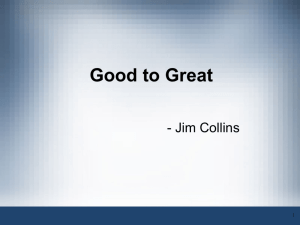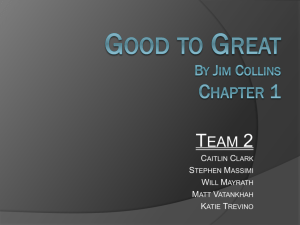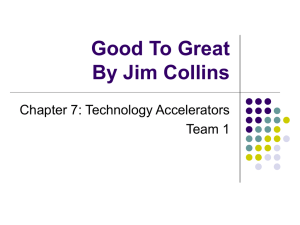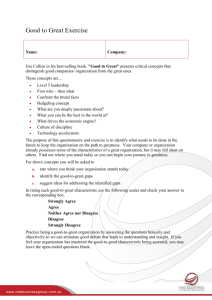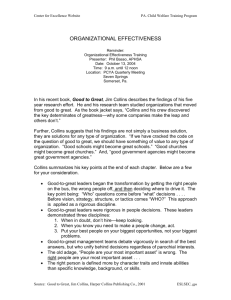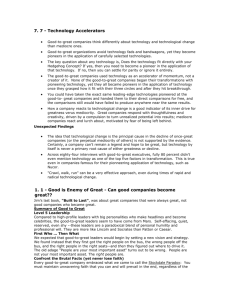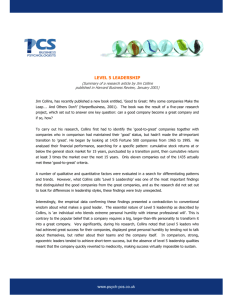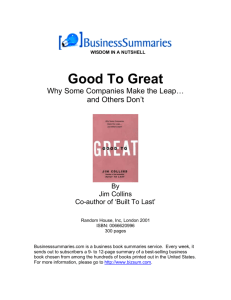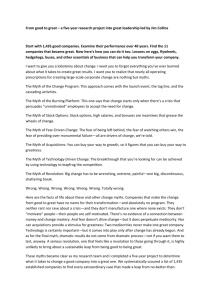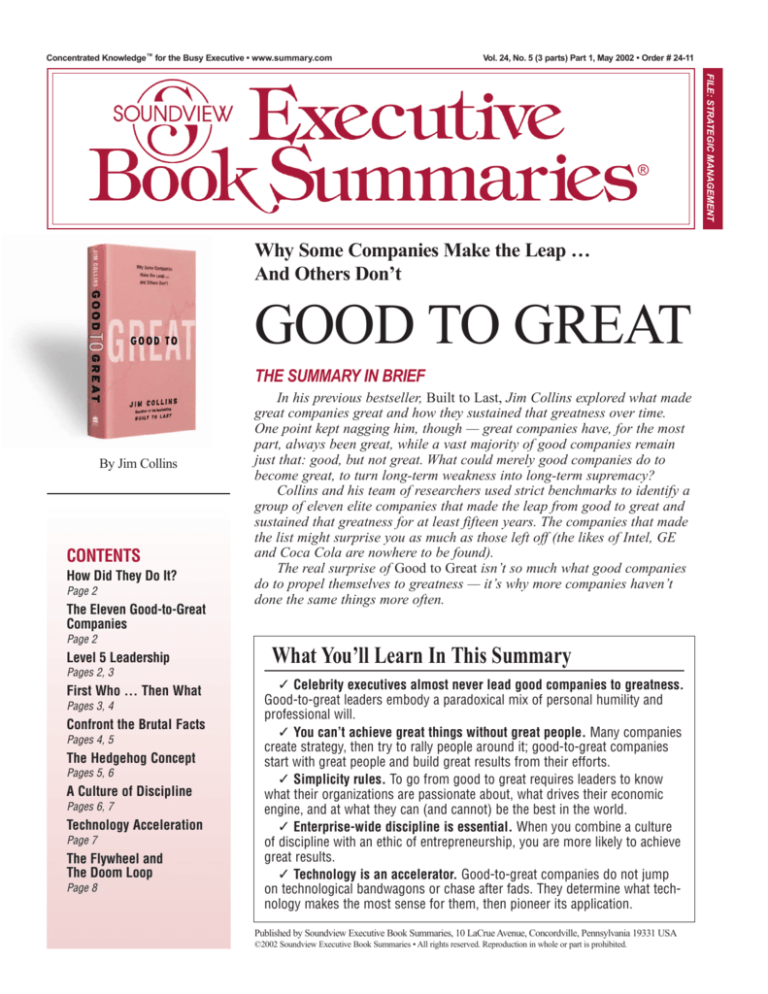
Concentrated Knowledge™ for the Busy Executive • www.summary.com
Vol. 24, No. 5 (3 parts) Part 1, May 2002 • Order # 24-11
Why Some Companies Make the Leap …
And Others Don’t
GOOD TO GREAT
THE SUMMARY IN BRIEF
By Jim Collins
CONTENTS
How Did They Do It?
Page 2
The Eleven Good-to-Great
Companies
In his previous bestseller, Built to Last, Jim Collins explored what made
great companies great and how they sustained that greatness over time.
One point kept nagging him, though — great companies have, for the most
part, always been great, while a vast majority of good companies remain
just that: good, but not great. What could merely good companies do to
become great, to turn long-term weakness into long-term supremacy?
Collins and his team of researchers used strict benchmarks to identify a
group of eleven elite companies that made the leap from good to great and
sustained that greatness for at least fifteen years. The companies that made
the list might surprise you as much as those left off (the likes of Intel, GE
and Coca Cola are nowhere to be found).
The real surprise of Good to Great isn’t so much what good companies
do to propel themselves to greatness — it’s why more companies haven’t
done the same things more often.
Page 2
Level 5 Leadership
Pages 2, 3
First Who ... Then What
Pages 3, 4
Confront the Brutal Facts
Pages 4, 5
The Hedgehog Concept
Pages 5, 6
A Culture of Discipline
Pages 6, 7
Technology Acceleration
Page 7
The Flywheel and
The Doom Loop
Page 8
What You’ll Learn In This Summary
✓ Celebrity executives almost never lead good companies to greatness.
Good-to-great leaders embody a paradoxical mix of personal humility and
professional will.
✓ You can’t achieve great things without great people. Many companies
create strategy, then try to rally people around it; good-to-great companies
start with great people and build great results from their efforts.
✓ Simplicity rules. To go from good to great requires leaders to know
what their organizations are passionate about, what drives their economic
engine, and at what they can (and cannot) be the best in the world.
✓ Enterprise-wide discipline is essential. When you combine a culture
of discipline with an ethic of entrepreneurship, you are more likely to achieve
great results.
✓ Technology is an accelerator. Good-to-great companies do not jump
on technological bandwagons or chase after fads. They determine what technology makes the most sense for them, then pioneer its application.
Published by Soundview Executive Book Summaries, 10 LaCrue Avenue, Concordville, Pennsylvania 19331 USA
©2002 Soundview Executive Book Summaries • All rights reserved. Reproduction in whole or part is prohibited.
FILE: STRATEGIC MANAGEMENT
®
GOOD TO GREAT
by Jim Collins
— THE COMPLETE SUMMARY
How Did They Do It?
The author and his team of researchers established the
good-to-great benchmark as follows:
● The companies had to have experienced 15-year
cumulative stock returns that were at or below the general stock market, punctuated by a transition point, then
cumulative returns at least three times the market over
the next fifteen years.
● Each company had to demonstrate the good-to-
BUILDUP ...
BR
E
T
AK
HR
O
UG
H!
FIRST WHO ... CONFRONT THE HEDGEHOG CULTURE OF TECHNOLOGY
LEVEL 5
LEADERSHIP THEN WHAT BRUTAL FACTS CONCEPT DISCIPLINE ACCELERATORS
DISCIPLINED PEOPLE
DISCIPLINED THOUGHT
DISCIPLINED ACTION
F
L Y
W H E E L
The Eleven
Good-to-Great Companies
✓
✓
✓
✓
✓
✓
Abbott
Fannie Mae
Kimberly-Clark
Nucor
Pitney Bowes
Wells Fargo
✓
✓
✓
✓
✓
Circuit City
Gillette
Kroger
Philip Morris
Walgreens
great pattern independent of its industry.
● Each company had to demonstrate a pattern of
results.
● Each company was compared to other similar companies that either never made the good-to-great leap (or
made it but did not sustain it), in order to determine
what distinguished the good-to-great company from all
others.
When the dust cleared and the good-to-great companies were identified, the author and his researchers
found distinct patterns of behavior in those who led
each company and the people who followed them —
patterns that concerned disciplined people, thought and
action. ■
DISCIPLINED PEOPLE
Level 5 Leadership
One of the most surprising results of the research of
good-to-great companies was in the discovery of the
type of leadership required to turn a good company into
a great one. One might think that such companies are
led by high-profile leaders with big personalities, those
who make headlines and become celebrities.
Yet, those leaders who seek and thrive in the spotlight
do not exude what can be termed “Level 5 Leadership”
behaviors (the term Level 5 refers to the highest level in
a hierarchy of executive capabilities as shown in the
chart on the following page). Leaders of this type —
those who combine extreme personal humility with
intense professional will — shun the attention of
celebrity, channeling their ambition toward the goal of
building a great company. Those leaders might run different companies in different markets, but they exemplify the same basic set of qualities:
(continued on page 3)
The author: Jim Collins is co-author of the national
bestseller, Built to Last. A former faculty member of the
Stanford University Graduate School of Business, he
directs a management research laboratory in Colorado.
Copyright© 2001 by Jim Collins. Summarized by permission of the publisher, HarperBusiness, 10 E. 53rd
Street, New York, NY. 300 pages. $27.50. 0-06-662099-6.
For more information on the author, go to:
http://my.summary.com
Published by Soundview Executive Book Summaries (ISSN 0747-2196), 10 LaCrue Avenue, Concordville, PA 19331 USA, a division of Concentrated
Knowledge Corporation. Publisher, George Y. Clement. V. P. Publications, Maureen L. Solon. Editor-in-Chief, Christopher G. Murray. Published monthly.
Subscriptions: $195 per year in U.S., Canada & Mexico, and $275 to all other countries. Periodicals postage paid at Concordville, PA and additional offices.
Postmaster: Send address changes to Soundview, 10 LaCrue Avenue, Concordville, PA 19331. Copyright © 2002 by Soundview Executive Book Summaries.
Available formats: Summaries are available in print, audio and electronic formats. To subscribe, call us at 1-800-521-1227 (1-610-558-9495 outside U.S. &
Canada), or order on the Internet at www.summary.com. Multiple-subscription discounts and Corporate Site Licenses are also available.
2
Soundview Executive Book Summaries ®
Good To Great — SUMMARY
Level 5 Hierarchy
Level 5 Level 5 Executive
Builds enduring greatness through a paradoxical
blend of personal humilty and professional will.
Level 4 Effective Leader
Catalyzes commitment to and vigorous pursuit of a clear and
compelling vision, stimulating higher performance standards.
Level 3 Competent Manager
Organizes people and resources toward the effective
and efficient pursuit of predetermined objectives.
Level 2 Contributing Team Member
Contributes individual capabilities to the achievement of group
objectives and works effectively with others in a group setting.
Level 1 Highly Capable Individual
Makes productive contributions through talent, knowledge,
skills and good work habits.
Level 5 Leadership
(continued from page 2)
● They set up successors for success. Many leaders
fail to set their companies up for success when they
depart, or pick a weak leader to replace them at the helm
— after all, what better testament to your own personal
greatness than that the place falls apart after you leave?
Level 5 leaders like Fannie Mae’s former CEO, David
Maxwell, make sure those who follow them are poised
to continue a successful path, or to exceed the expectations that arise as a result of that success. Maxwell came
under fire from Congress for the perceived excessiveness
of his $20 million retirement package (Fannie Mae operates under a government charter). Instead of serving his
own self-interest and taking the money, he instructed his
successor to withhold the remaining balance of $5.5 million, saving the company from a potentially bad (not to
mention threatening) relationship with Washington.
● They are compellingly modest. In contrast to the
very I-centric style of some other leaders, Level 5 leaders
do not typically talk about themselves, preferring to direct
attention to other individuals, or to the results of the company as a whole. They don’t aspire to be larger-than-life
heroes, or to be placed on a pedestal. They are seemingly
ordinary people quietly producing extraordinary results.
● They have unwavering resolve. Level 5 leaders do
not simply exude modesty or humility; they also have a
ferocious resolve, an almost stoic determination to do
whatever needs to be done to make the company great.
When George Cain became CEO of Abbott
Laboratories, the company occupied a lowly space in
the pharmaceutical industry. Cain didn’t have an inspiring personality to galvanize the company, but he did
have a steadfast intolerance for mediocrity; good was
simply not good enough. He destroyed the company’s
most glaring causes of its mediocrity — nepotism — by
rebuilding the board and executive teams with the best
people available, not just those who had family connections or had been with the company longest.
Want to find out if one of your managers has the potential for Level 5 leadership? Look for situations where
extraordinary results exist, but where no individual steps
forth to claim excess credit. Want to be a Level 5 leader?
Read on; now that you know what a Level 5 leader is,
you are ready to discover what a Level 5 leader does. ■
First Who … Then What
One of the things most people assume they will find
when studying good-to-great companies is a compelling, new vision, strategy, or direction, around which
management will gain people’s commitment.
The truth is quite the opposite. Executives who ignited transformations from good to great did not first figure out where to drive the bus, then get the people to
take it there. Instead, they first got the right people on
the bus (and the wrong people off) and then figured out
where to drive it. “Who” questions must come before
(continued on page 4)
Wells Fargo’s
Rigorous People Decision
Wells Fargo began its fifteen-year stint of spectacular performance in 1983, but the foundation of the
shift began in the early 1970s, when then-CEO Dick
Cooley first foresaw that the banking industry would
eventually undergo wrenching change. Because he
could not envision the breadth or form of that
change, he focused on “injecting an endless stream
of talent” into the veins of the company, building a
talent-stocked team that could handle any exigency.
Under Cooley’s direction, Wells Fargo hired outstanding people whenever and wherever they could
find them, often without a specific job in mind. Some
of these people would go on to become executives; all
of them were responsible for the company’s high performance, even in the face of extreme industry change.
At a time when its sector of the banking industry fell
59 percent behind the general stock market, Wells
Fargo outperformed the market by a 3-to-1 margin.
Soundview Executive Book Summaries ®
3
Good To Great — SUMMARY
First Who … Then What
(continued from page 3)
“what” decisions — before vision, before strategy,
before organization structure, before tactics.
Simple Truths
Good-to-great leaders understand three simple truths:
● If you begin with the “who,” rather than the
“what,” you can more easily adapt to a changing world.
● If you have the right people on the bus, the problem of how to motivate and manage people largely
goes away.
● If you have the wrong people, it doesn’t matter
whether you discover the right direction—you still
won’t have a great company. Great vision without
great people is irrelevant.
Good-to-great companies tend to have rigorous cultures — cultures in which leadership consistently
applies exacting standards at all times and at all levels,
especially upper management. To be rigorous means
that the best people need not worry about their positions, leaving them to concentrate fully on doing their
best work. It can also mean being up front about the
need to let people go, if that is warranted.
To be rigorous in people decisions means first becom-
ing rigorous about top management people decisions,
and to following three practical disciplines:
● When in doubt, don’t hire — keep looking. No
company can grow revenues consistently faster than its
ability to get enough of the right people to implement
that growth and still become a great company. If your
growth rate in revenues consistently outpaces your
growth rate in people, you cannot build a great company.
● When you know you need to make a people
change, act. The moment you feel the need to tightly
manage someone, you’ve made a hiring mistake. The
best people don’t need to be managed — guided, taught,
led, yes, but not tightly managed. Don’t delay, try different alternatives, give third or fourth chances, or build systems to compensate for shortcomings. Letting the wrong
people hang around is unfair to all the right people, who
often find themselves compensating for the wrong people’s inadequacies. Get the wrong people off the bus.
● Put your best people on your biggest opportunities, not your biggest problems. Many companies
think that putting their best people in bad situations will
help turn the bad situation around. While this sometimes works to everyone’s advantage, managers who do
so fail to grasp the fact that managing your problems
can only make you good. Building opportunities is the
only way to become great. ■
DISCIPLINED THOUGHTS
Confront the Brutal Facts
All good-to-great companies began the process of
finding a path to greatness by confronting the brutal
facts of their current reality. When a company starts
with an honest and diligent effort to determine the truth
of its situation, the right decisions often become selfevident. Good decisions are impossible without an honest confrontation of the brutal facts.
Why Kroger Beat A&P
The Great Atlantic and Pacific Tea Company (also
known as A&P) had the perfect business model for the
first half of the twentieth century, when two world wars
and an economic depression imposed frugality upon
Americans: cheap, plentiful groceries sold in utilitarian
stores. However, in the more affluent second half of the
century, Americans began demanding bigger stores,
more choices, fresh baked goods, fresh flowers, banking
services and so forth. They wanted superstores that
offered almost everything under one roof.
To face the brutal facts about the mismatch between its
past model and the changing world, A&P opened a new
store called Golden Key, where it could experiment with
new methods and models and learn what customers
4
wanted. It sold no A&P-branded products, experimented
with new departments, and began to evolve toward the
(continued on page 5)
When “I Don’t Know”
Is the Right Answer
When Alan Wurtzel assumed the CEO post of
Wards (the hi-fi and appliance seller that would one
day become Circuit City), the company stood at the
brink of bankruptcy, its stores a hodgepodge of
loosely connected units with no unifying concept.
When asked where he was going to take the company, Wurtzel answered honestly: “I don’t know.”
Rather than claiming he had the right answers,
Wurtzel got the right people on the bus and began
asking questions, sparking debates in the company
boardroom and on the executive team. At each step
along the way on the company’s turnaround path,
Wurtzel would keep asking questions until he had a
clear picture of reality and its implications.
By asking questions, leaders at good-to-great companies create a forum where current realities bubble
to the surface and can be addressed honestly.
Soundview Executive Book Summaries ®
Good To Great — SUMMARY
Confront the Brutal Facts
The Hedgehog Concept
(continued from page 4)
more modern superstore. A&P began to discover the
answer to the questions of why it was losing market
share and what it could do about it. But A&P executives
didn’t like the answers they got, so they closed the store,
rather than diverge from their ages-old business ideas.
Meanwhile, the Kroger grocery chain also conducted
experiments and, by 1970, discovered the inescapable
truth that the old-model grocery store was going to
become extinct. Rather than ignore the brutal truth, as
A&P did, the company acted on it, eliminating, changing, or replacing every single store that did not fit the
new realities. It went block-by-block, city-by-city, stateby-state, until it had rebuilt its entire system. By 1999,
it was the number one grocery chain in America.
Let the Truth Be Heard
One of the primary tasks in taking a company from
good to great is to create a culture wherein people have
a tremendous opportunity to be heard and, ultimately,
for the truth to be likewise heard.
To accomplish this, you must engage in four basic
practices:
● Lead with questions, not answers. Leading from
good to great does not mean coming up with the
answers and motivating everyone to follow your messianic vision. It means having the humility to grasp the
fact that you do not yet understand enough to have the
answers, and then to ask questions that will lead to the
best possible insights.
● Engage in dialogue and debate, not coercion. All
good-to-great companies have a penchant for intense
debates, discussions and healthy conflict. Dialogue is not
used as a sham process to let people “have their say” so
they can buy into a predetermined decision; rather, it is
used to engage people in the search for the best answers.
● Conduct autopsies, without blame. Good-to-great
leaders must take an honest look at decisions his or her
company makes, rather than simply assigning blame for
the outcomes of those decisions. These “autopsies” go a
long way toward establishing understanding and learning, creating a climate where the truth is heard.
● Build red flag mechanisms that turn information
into information that cannot be ignored. Good-togreat companies have no better access to information
than any other company; they simply give their people
and customers ample opportunities to provide unfiltered
information and insight that can act as an early warning
for potentially deeper problems. ■
For more information on the root causes of A&P’s troubles, go to:
http://my.summary.com
In his famous essay “The Hedgehog and the Fox,”
Isaiah Berlin divided the world into two groups, based
on an ancient Greek proverb, which pitted the two natural enemies against each other. Foxes pursue many ends
at the same time and see the world in all its complexity;
they are scattered or diffused, moving on many levels,
never integrating their thinking into one overall concept
or unifying vision. Hedgehogs, on the other hand, simplify a complex world into a single idea or principle
that unifies and guides everything. Regardless of the
world’s complexity, the hedgehog reduces all challenges
and dilemmas to simple ideas — anything that does not
somehow relate to the hedgehog idea holds no relevance. When foxes and hedgehogs are pitted against one
another, the hedgehog always wins.
Three Key Dimensions
Those who built the good-to-great companies were, to
one degree or another, hedgehogs. They used their hedgehog nature to drive toward a Hedgehog Concept, a simple, crystalline concept that flows from deep understand(continued on page 6)
The “Best in the World”
Understanding
The following are among the good-to-great companies that attained an understanding of what they
could be best in the world at, and what they did with
that understanding:
✓ Abbott Laboratories understood it could become
the best at creating a product portfolio that would
lower the cost of health care. The company confronted the reality that it could not become the best pharmaceutical company in the world, despite the fact that
99 percent of its revenue at one time came from
pharmaceuticals. It shifted its focus to creating that
lower-cost product portfolio, principally hospital
nutritionals, diagnostics and hospital supplies.
✓ Nucor understood it could become the best at
harnessing culture and technology to produce low-cost
steel. The company came to see that it had tremendous skill in two activities—creating a performance
culture and making farsighted bets on new technologies. By combining these two, it was able to become
the lowest-cost steel producer in the United States.
✓ Kimberly-Clark understood it could become the
best in the world at paper-based consumer products.
The company realized it had a latent skill at creating
“category-killer” brands (brands that were synonymous with their products, like Kleenex) in paperbased products.
Soundview Executive Book Summaries ®
5
Good To Great — SUMMARY
The Hedgehog Concept
Three Circles of the Hedgehog Concept
(continued from page 5)
ing about the intersection of the three key dimensions:
● At what you can be best in the world. This standard goes far beyond core competence — just because
you possess a core competence doesn’t necessarily
mean you are the best in the world at that competence.
Conversely, what you can be best in the world at might
not even be something in which you are currently
engaged. The Hedgehog Concept is not a goal or strategy to be the best at something; it is an understanding of
what you can be the best at and, almost equally important, what you cannot be the best at.
● What drives your economic engine. To get insight
into the drivers of your economic engine, search for the
one denominator (profit per x, for example, or cash flow
per x) that has the single greatest impact. If you could
pick one and only one ratio to systematically increase
over time to make a greater impact, what would that ratio
be? This denominator can be subtle, sometimes even
unobvious. The key is to use the denominator to gain
understanding and insight into your economic model.
● What you are deeply passionate about. Good-togreat companies did not pick a course of action, then
What You Are Deeply
Passionate About
What You Can
Be The Best In
The World At
What Drives
Your
Economic
Engine
encourage their people to become passionate about their
direction. Rather, those companies decided to do only
those things that they could get passionate about. They
recognized that passion cannot be manufactured, nor
can it be the end result of a motivation effort. You can
only discover what ignites your passion and the passions of those around you. ■
For the complete parable of “The Hedgehog and the Fox,” go to:
http://my.summary.com
DISCIPLINED ACTION
A Culture of Discipline
Sustained great results depend upon building a culture
full of self-disciplined people who take disciplined
action fanatically consistent with the three circles of the
Hedgehog Concept.
This is in contrast to the typical ways in which many
companies (particularly start-ups) conduct themselves
when responding to growth and success. As these companies grow, they tend to sacrifice the creativity, energy and vision that made them successful in favor of
hierarchical, bureaucratic structures and strictures —
thus killing the entrepreneurial spirit as they create
order. Exciting companies thus transform themselves
into ordinary companies, and mediocrity begins to
grow in earnest.
Indeed, bureaucratic cultures arise to compensate for
incompetence and lack of discipline, which arise from
having the wrong people on the bus in the first place.
Most companies build their bureaucratic rules to manage a small percentage of the wrong people, which in
turn drives away the right people.
This self-perpetuating problem can be avoided by creating a culture of discipline.
Action Steps
To create a culture of discipline, you must:
● Build a culture around the idea of freedom and
responsibility, within a framework. Good-to-great
companies built a consistent system with clear constraints, but they also gave people freedom and responsibility within the framework of that system. They hired
self-disciplined people who didn’t need to be managed,
and then managed the system, not the people. They also
had the discipline of thought, to confront the brutal facts
of reality and still maintain faith that they were on the
track to greatness. Finally, they took disciplined actions
that kept them on that track.
● Fill your culture with self-disciplined people who
are willing to go to extreme lengths to fulfill their
responsibilities. People in good-to-great companies
tend to be almost fanatical in the pursuit of greatness;
they possess the discipline to do whatever it takes to
become the best within carefully selected arenas, and
then seek continual improvement from there. While
everyone would like to be the best, most organizations
lack the discipline to figure out with egoless clarity
what they can be the best at, and the will to do whatever
(continued on page 7)
6
Soundview Executive Book Summaries ®
Good To Great — SUMMARY
A Culture of Discipline
Walgreens and Technology
(continued from page 6)
it takes to turn that potential into reality.
● Don’t confuse a culture of discipline with a
tyrannical disciplinarian. Many companies that could
not sustain their success had leaders who personally disciplined the organization through sheer force. Good-togreat companies had Level 5 leaders who built an
enduring culture of discipline, powered by self-disciplined people who acted in the company’s best interests
without strict dictums from leadership.
These disciplined companies could and did thrive
even after their leaders had departed the organization;
those companies that practiced discipline only by tyrannical rule could not sustain themselves once their leaders departed.
● Adhere with great consistency to the Hedgehog
Concept, exercising an almost religious focus on the
intersection of the three circles. The good-to-great
companies at their best followed a simple mantra —
“Anything that does not fit with our Hedgehog Concept,
we will not do.” They did not launch unrelated businesses or joint ventures in an effort to diversify. They did
not panic if the competitive landscape shifted. If a
course of action did not fit into their disciplined
approach, they did not perform that action. It takes discipline to say “No” to such opportunities. ■
For more information on one athlete’s fanatical discipline, go to:
http://my.summary.com
Technology Acceleration
Good-to-great organizations think differently than
mediocre organizations about technology and technological change. They avoid the fads and bandwagons that
typically arise from new technology, instead becoming
pioneers in the application of carefully selected technologies. When used correctly, technology becomes an
accelerator of momentum, not a creator of it.
Find the Right Technologies
Good-to-great companies never began their transitions
with pioneering technology, for the simple reason that
you cannot make good use of technology until you
know which technologies are relevant — the ones that
link directly to the three intersecting circles of the
Hedgehog Concept. Examples of this approach abound
in the list of good-to-great companies:
● Circuit City pioneered the application of sophisticated point-of-sale and inventory-tracking technologies,
both of which were linked to the concept of being the
“McDonald’s” of big-ticket retailing, able to operate a
Walgreens pioneered the use of satellite communications and computer network technology, linked to
its concept of convenient corner drugstores, tailored
to the unique needs of specific demographics and
locations. Walgreens also approached the Internet
with great care, even in the face of new, technologydriven competition.
geographically dispersed system with great consistency.
● Gillette pioneered the application of sophisticated
manufacturing technology for making billions of hightolerance products at low cost with fantastic consistency. The company protects its manufacturing technology
secrets with the same fanaticism that Coca-Cola protects its cola formula.
● Philip Morris pioneered the application of both
packaging and manufacturing technology, including the
technology to make flip-top boxes — the first tobacco
industry packaging innovation in twenty years. The
company also was the first to use computer-based manufacturing, making an enormous investment in a manufacturing center to experiment with, test and refine
advanced manufacturing and quality techniques.
Don’t Overreact to New Technology
How a company reacts to technological change is a
good indicator of its inner drive for greatness versus
mediocrity. Leaders of good-to-great companies respond
with thoughtfulness and creativity, driven by a compulsion to turn unrealized potential into results. They do not
take reactionary measures, defining strategy in response
to what others are doing. They act in terms of what they
want to create, and how to improve their companies, relative to an absolute standard of excellence.
Mediocre companies, on the other hand, react and
lurch about, motivated chiefly by the fear of what they
don’t understand — a fear of watching others hit it big
while they’re left behind. Never was there a better
example of this difference than during the technology
bubble of the late 1990s, when mediocre companies
moved from one technological scheme to the next,
always reacting, never pioneering. The great companies
acted with calm equanimity, taking quiet, deliberate
steps forward, with great discipline.
Those organizations that stay true to their fundamentals and maintain their balance will accumulate the
momentum required to break through; those that do not
will spiral downward or remain mediocre. ■
For more information on Walgreens Internet battles, go to:
http://my.summary.com
Soundview Executive Book Summaries ®
7
Good To Great — SUMMARY
BUILDUP AND BREAKTHROUGH
The Flywheel and
The Doom Loop
Good-to-great transformations often look like dramatic, revolutionary events to those observing from the outside, but they feel like organic, cumulative processes to
people on the inside. The confusion of end outcomes
(dramatic results) with process (organic and cumulative)
skews our perception of what really works over the long
haul. Those companies had no name for their transformations; there was no launch event, no tag line, no programmatic feel whatsoever.
There was, in other words, no miracle moment in the
transformation of each company from good to great.
Each went through a quiet, deliberate process of figuring out what needed to be done to create the best future
results, then they simply took those steps, one by one
over time, until they hit their breakthrough moments.
The Flywheel Effect
Their successes can be seen in the following illustration: Imagine an enormous, heavy flywheel — a massive disc mounted horizontally on an axle, measuring 30
feet in diameter, two feet in thickness and 5,000 pounds
in weight. In order to get the flywheel moving, you
must push it. Its progress is slow; your consistent efforts
may only move it a few inches at first. Over time, however, it becomes easier to move the flywheel, and it
rotates with increasing ease, carried along by its
momentum. The breakthrough comes when the wheel’s
own heavy weight does the bulk of the work for you,
with an almost unstoppable force.
Each of the good-to-great companies experienced the
flywheel effect in their transformations. The first efforts
in each transformation were almost imperceptible. Yet,
over time, with consistent, disciplined actions propelling it forward, each company was able to build on
its momentum and make the transformation — a buildup that led to a breakthrough. The momentum they built
was then able to sustain their success over time.
These companies understood a simple truth: Tremendous
power exists in the fact of continued improvement and the
delivery of results. Point to tangible accomplishments —
however incremental at first — and show how those steps
fit into the context of an overall concept that will work.
When this is done in such a way that people see and feel
the buildup of momentum, they will line up with enthusiasm. This is the real flywheel effect.
When a leader lets the flywheel do the talking, he or
she does not need to fervently communicate the organization’s goals — people can just extrapolate from the
momentum of the flywheel for themselves. As people
8
decide among themselves to turn the fact of potential
into the fact of results, the goal almost sets itself.
People want to be part of a winning team, producing
visible, tangible results.
The Doom Loop
Other companies exhibited very different patterns.
Instead of a quiet, deliberate process of figuring out
what needed to be done, then doing it, these companies
frequently launched new programs — often loudly, with
the aim of “motivating the troops” — only to see those
programs fail to produce sustained results. They pushed
the flywheel in one direction, stopped, changed course
and pushed it in a new direction, a process they repeated continually. After years of lurching back and forth,
these companies failed to build sustained momentum
and fell into what could be termed the doom loop.
Are You on the Flywheel or in the Doom Loop?
How can you tell if your organization is on the flywheel, or in the doom loop? Consider the following:
You’re on the flywheel if you—
● Follow a pattern of buildup, leading to breakthrough.
● Confront the brutal facts to see what steps must be
taken to build momentum.
● Attain consistency with a clear Hedgehog Concept,
staying within the three circles.
● Follow the pattern of disciplined people, thought
and action.
● Harness appropriate technologies to your Hedgehog
Concept, to accelerate momentum.
● Spend little energy trying to motivate or align people; the momentum of the flywheel is infectious.
● Maintain consistency over time.
You’re in the doom loop if you—
● Skip buildup and jump right into breakthrough.
● Implement big programs, radical change efforts,
dramatic revolutions and chronic restructuring.
● Embrace fads and engage in management hoopla,
rather than confront the brutal facts.
● Demonstrate chronic inconsistency, lurching back
and forth and straying outside the three circles.
● Jump right into action, without disciplined thought,
or first getting the right people on the bus.
● Spend a lot of energy trying to align and motivate
people, rallying them around new visions.
● Sell the future to compensate for lack of results in
the present. ■
For more information on one company’s flywheel discovery, go to:
http://my.summary.com
Soundview Executive Book Summaries ®


